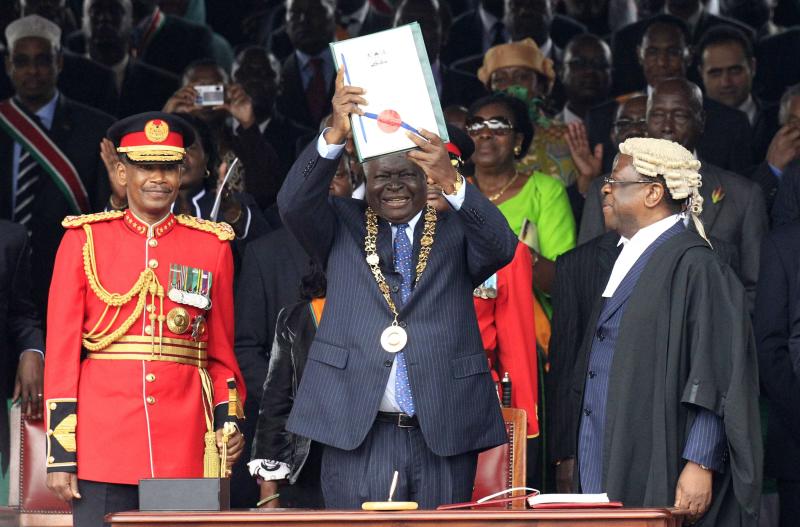

As Kenyans wait eagerly for the Court of Appeal verdict on the Building Bridges Initiative (BBI) ruling of May 13, 2021, the grain of Kenya’s constitutional history reveals a mischievous power play with the independence Constitution between 1964 and 2008.
The Constitution was tinkered with at least 27 times, making a wide range of amendments each time.
In a strange twist of irony, some of the amendments returned to haunt the architects. (Read more on this here.)
The constitutional changes:
1. Constitution of Kenya (Amendment) Act No. a28 of 1964: Assented to on 23 November 1964. Established the office of the President and Vice President. Enabled Mzee Kenyatta to transition to President on 12 December 1964 and Oginga Odinga Vice President.

 playbook in battle with Gachagua to reclaim Mt Kenya" />
playbook in battle with Gachagua to reclaim Mt Kenya" />


3. Constitution of Kenya (Amendment) Act No. 14 of 1965: Curtain raiser to detention without trial. It amended approval for a state of emergency by Parliament to a simple majority. Amendment of the constitution was amended from 90 per cent in the Senate and 75 per cent in the House of Representatives both placed at 65 per cent.
4. Constitution of Kenya (Amendment) Act No. 17 of 1966: Introduced the requirement for the Speaker’s permission for MPs absent for more than eight consecutive days. Such an MP would lose their seat unless pardoned by the President
5. Constitution of Kenya (Amendment) Act No. 17 of 1966: Calculated to tame KPU defectors after Limuru I Conference. An MP resigning from a political party to lose the seat and seek a fresh mandate.
6. Constitution of Kenya (Amendment) Act No. 18 of 1966: State of emergency powers removed from Parliament and handed the President. The start of detention without trial.
7. Constitutional Amendment Act No. 40 of 1966: Abolished the Senate and House of Representatives. Created the National Assembly. Senators were absorbed into the assembly.
8. Constitution of Kenya (Amendment) Act No. 16 of 1968: Killed and buried federalism. All provincial councils were abolished. All regionalism laws were repealed.
9. Constitutional Amendment Act No. 45 of 1968: Driven by fear of a parliamentary coup. President to be elected by the public and not through Parliament by MPs.
10. Constitutional of Kenya Act No.5 of 1969: An omnibus amendment that gave the president more powers, such as the appointment of the Electoral Commission. Previously powers belonged to the Speaker of the National Assembly.
11. Constitution of Kenya (Amendment) Act of 1974: Lowered the voting age from 21 years to 18 years. Recognized use of Kiswahili in the National Assembly.
Stay informed. Subscribe to our newsletter
12. Constitution of Kenya (Amendment) Act of 1975: Allowed presentation of Parliamentary Bills in both English and Kiswahili.
13. Constitution of Kenya (Amendment) Act No. 14 of 1975: Gave the president the sole power to forgive various kinds of law offenders, including pardoning election offenders. More immediately sought to allow Paul Ngei to run for Kangundo Constituency after election nullification for election offences.
14. Constitution of Kenya (Amendment) Act No. 13 of 1977: Established the Court of Appeal of Kenya after the demise of the East African Community. Chief Justice tallowed to sit both as a High Court judge and a Court of Appeal judge.
15. Constitution of Kenya (Amendment) Act No. 1 of 1979: Affirmed dual use of English and Kiswahili in Parliament. To address language challenges by members with difficulties in Kiswahili.
16. Constitution of Kenya (Amendment) Act No. 5 of 1979: Public servants wishing to contest parliamentary elections to resign at least six months to nominations for the elections. Political class seeking to lock out public servants, with exactly to the elections.
17. Constitution of Kenya (Amendment) Act of 1982: Introduced Section 2A to the Constitution, which converted Kenya into a one-party state. Calculated to Odinga and radical politicians out of competitive politics.
18. Constitution of Kenya (Amendment) Act No. 7 of 1984: Gave the High Court the last word on election petitions.
19. Constitution of Kenya (Amendment) Act No. 6 of 1985: The limited right to citizenship by repealing Section 89 of the Constitution.
20. Constitution of Kenya (Amendment) Act No. 14 of 1986: Removed security of tenure for Attorney General, Controller, and Auditor General. Compromised independence of critical state officers. Also increased the number of parliamentary constituencies to a maximum of 188 and a minimum of 168.
21. Constitution of Kenya (Amendment) Act No. 20 of 1987: Made non-bailable capital offences punishable by death under the Penal code (Cap 62).
22. Constitution of Kenya (Amendment) Act No. 4 of 1988: An increased period of holding capital offence suspects before court presentation from 24 hours to 14 days. Removed security of tenure for Public Service Commissioners, High Court judges and Court of Appeal judges. Created the Offices of the Chief Magistrate and Principal Magistrate.
23. Constitution of Kenya (Amendment) Act No. 2 of 1990: Restored security of tenure for Public Service Commissioners, High Court judges and Court of Appeal judges, due to civil society pressure.
24. Constitution of Kenya (Amendment) Act No. 10 of 1991: Raised the maximum number of constituencies to 210, up from 188.
25. Constitution of Kenya (Amendment) Act No. 12 of 1991: Repealed Section 2A of the Constitution. Restored multiparty politics.
26. Constitution of Kenya (Amendment) Act No. 10 of 1997: Introduced Section 1A. Reinforced multiparty democracy. Also amended Sections 7, 33, 41, 42A, 82 and 84. Empowered President to appoint ministers from MPs from other political parties. Nomination of special MPs to Parliament removed from the president to MPs. Sweeping democratic changes introduced.
27. Constitution of Kenya (Amendment) Act 2008: Created a coalition government with a president and prime minister with two deputy prime ministers. Allowed Kibaki and Odinga to share power after the botched election of 2007.